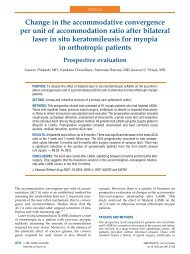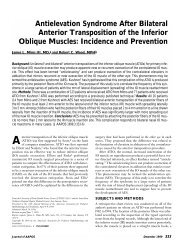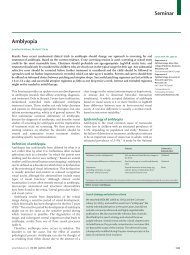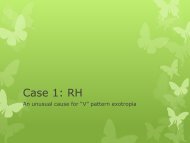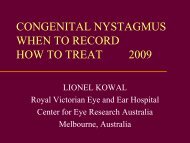What's new AAPOS 2008 - The Private Eye Clinic
What's new AAPOS 2008 - The Private Eye Clinic
What's new AAPOS 2008 - The Private Eye Clinic
You also want an ePaper? Increase the reach of your titles
YUMPU automatically turns print PDFs into web optimized ePapers that Google loves.
<strong>The</strong>y performed high-resolution chromosome analysis of 11p13 on 193 aniridia cases<br />
and subsequently FISH analysis. FISH analysis of aniridia patients identifies individuals<br />
with WT1 deletions regardless of whether or not they have Wilms tumor, allowing the<br />
deletion size to be correlated with clinical outcome. Wilms tumor was not observed in<br />
any case without a WT1 deletion. Of those individuals in which WT1 was deleted, 77%<br />
with submicroscopic deletions (detectable only by high resolution FISH) presented with<br />
Wilms tumor compared to 42.5% with visible deletions (detectable by microscope).<br />
High resolution deletion analysis is a useful tool for assessing the risk of Wilms tumor in<br />
neonates with aniridia. Individuals with submicroscopic WT1 deletions have a<br />
significantly increased risk of Wilms tumor and a high level of vigilance should be<br />
maintained in such cases.<br />
Ocular involvement in children with localized scleroderma: A multicenter study.<br />
Zannin ME, Martini G, Athreya BH, Russo R et al.<br />
Br J Ophthalmol. 2007 May 2; [Epub ahead of print]<br />
Juvenile localized scleroderma (JLS) is the most frequent subtype of scleroderma in<br />
children. <strong>The</strong>re are 4 subtypes: 1) plaque morphea (PM), 2) generalized morphea, 3)<br />
deep morphea (DM), and 4) linear scleroderma LS). Each can involve the face,<br />
particularly the orbit.<br />
<strong>The</strong> authors present their collated data on ocular features from a large multinational<br />
study of children with LS. Twenty-four out of 750 patients (3.2%) had significant ocular<br />
involvement. But 14% of the patients with “en coup de saber” (ECDS) demonstrated<br />
ocular features. <strong>The</strong> most common was fibrotic involvement of the eyelids and/or<br />
lashes and/or lacrimal system with dry eyes. Anterior segment problems were seen in 7<br />
patients (29.2%) with anterior uveitis, the most common. Episcleritis was also seen and<br />
steroid resistant. One patient had paralytic strabismus. <strong>The</strong>se patients with ocular<br />
findings also demonstrated a high prevalence (50%) of concomitant involvement of<br />
other internal organs, particularly the CNS.<br />
<strong>The</strong> authors recommend careful ophthalmic monitoring in any patient with JLS, but<br />
mandatory in those with skin lesions on the face and/or concomitant CNS involvement.<br />
Retinal degeneration in children: Dark adapted visual threshold and arteriolar<br />
diameter.<br />
Hansen RM, Eklund SE, Benador IV, Mocko JA et al.<br />
Vision Res 2007 Aug; doi:10/1016/j.visres 2007.07.009.<br />
<strong>The</strong> authors assess the retina using dark adapted visual threshold (DAT) and arteriolar<br />
diameters in patients with Leber Congenital Amaurosis (LCA), Bardet-Biedl syndrome<br />
(BBS) and Usher syndrome (USH). <strong>The</strong> mutations causing LCA, BBS and USH<br />
58



